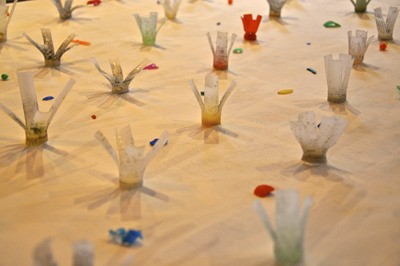It all started with clamshells. No, not the kind you’d find on the beach, but the hinged, clear plastic containers you might find at a salad bar, or the ones berries and baked goods come in.
An avid recycler, Liesl Clark came up empty when she tried to find a place that would take the polystyrene containers (marked with a 6 on the bottom).
Clark’s search led her to create a comprehensive recycling resources list, “Road Map to Zero Waste,” for Bainbridge Island residents (find it on www.sustainablebrainbridge.org). From there, Clark, whose documentaries were shown in a National Geographic series in November, went deeper and deeper into research on plastic.
In February, Clark and two other home-school moms, Rebecca Rockefeller and Stevie Schmidt, brought along bags to pick up trash, but what they found was stunning.
“I’ve had people say to me, I’ve been to this or that beach and I’ve never seen plastic. If I hadn’t been there, I would have said that too,” Clark said.
Within 10 minutes, the group filled several bags with lighters, straws, bottle caps and such, the type of trash you might expect to find. What was more disturbing was the amount of “micro-plastic,” small bits of broken- down plastic, that permeates the sand at a ratio of 1:5.
“It’s pretty and colorful, but when you really look, it’s everywhere,” Clark said.
When the troupe, including students Finn Clark, Ava Rockefeller, Autumn Schmidt, Cleo Clark-Athans, and Mira Rockefeller Campbell, got home, they began sorting the plastics by color and type.
“It’s modern archeology,” Clark said of the inventorying process. Some pieces were easy to detect: hundreds of clear firework casings, 12-guage shotgun cartridges, fishing nets. Others, added a little mystery.
The moms prepared five free-cycled canvas boards, and the children had fun creating art from the multicolored flotsam. Clark even started a spreadsheet tally of the types of trash they encountered. The kids, four to seven years old, learn about colors, counting, sorting, analyzing and even spelling. One “assemblage” spelled out the name of the beach from which the matter came.
“As a family, it’s helped us rethink our use of plastic,” Clark said. “Even my 4-year-old said “I don’t need a straw.”
Clark and the other families saw the accumulated effect of single-use disposable items such as plastic water bottles, small yogurt containers and plastic bags.
“It’s not benign,” Rockefeller said.
She saw the wisdom in relearning skills that our grandparents took for granted: baking bread, making yogurt, squeezing juice to reduce the need for so many plastic containers.
“You have to rethink everything. We can’t recycle our way out of this. We have to start thinking what can we use instead of plastic?”
To make a point and have fun doing it, Rockefeller decided to make refuse art at her birthday party. She invited two dozen friends to walk their favorite beach, collect stuff for 10 to 15 minutes and bring what they found to the party. Her friends were skeptical.
“I kept hearing, ‘We’ll find what we can, but we’re not sure how much.’”
What she heard later didn’t surprise her, all variations of the same message: most thought they might find a couple of things. This from people who went to these beaches on a regular basis. They didn’t see all the micro-plastic until they started looking for it, she said. Once they did, they realized it was everywhere.
In fact, researchers are just now beginning to grasp the enormity of the plastics problem. We throw it in the trash and it simply goes away. Right? Not according to Alan Weisman’s book “The World Without Us,” which estimates plastic’s lifespan at hundreds, if not thousands of years.
Scripps Institution of Oceanography’s Project Kaisei has been studying an area in the North Pacific the size of Texas that contains high concentrations of floating debris, now known as the Great Pacific Garbage Patch.
“Plastic is forever,” Clark said. “Micro-plastics in the marine environment now outweigh zooplankton 6:1.”
If the fish are eating the plastic and we’re eating the fish, we are in effect, poisoning ourselves, she said.
Port Townsend Marine Science Center is researching the amount of plastics found in seabirds and mammals.
The implications of the problem, for themselves and their children, motivated the women to produce an exhibit “Plastic is Forever,” featuring the colorful “assemblages” created from the refuse on local beaches.
The exhibit will be on display for Earth Day, April 24 at Oil & Water Arts, 278 Winslow Way, in the upper level. The art is both beautiful and disturbing. The bright and enticing colors are offset by the ugly truth the work conveys.



